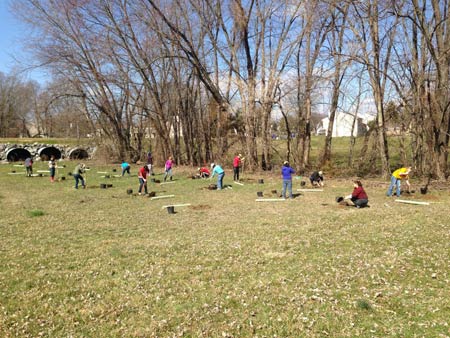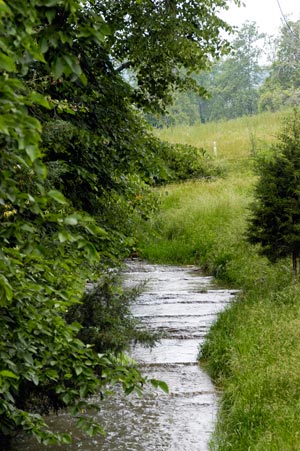By Tacy Lambiase
During my spring break “vacation,” I spent last week camping on the shore of the Chesapeake Bay near Annapolis, Md. With 13 of my fellow classmates from the University of Maryland’s Alternative Breaks program and a fearless staff advisor, I participated in service projects to improve the health of the Chesapeake Bay, a waterway plagued by pollution. Since the Chesapeake Bay is one of our nation’s natural treasures, not to mention an integral part of Maryland’s state identity, I wanted to explore the root causes of the problems facing this fragile ecosystem. But after spending two days planting trees along rivers that lead to the bay, I realized just how integral trees are to preserving the watershed and keeping the water clean.

Since agricultural and stormwater runoff are two of the main sources of pollution that flow into the bay, incredible amounts of nutrients like nitrogen and phosphorus end up in the water. These nutrients, in addition to sediment, are washed into the bay from farms, which use fertilizer containing these nutrients, and urban areas, where water cannot easily soak into the ground. Once in the bay, these pollutants stimulate the growth of algal blooms (large accumulations of algae) which use up the oxygen in the water, creating “dead zones” where other plants and aquatic life cannot survive.
A simple and natural way to mitigate the harmful effects of nutrient pollution, planting trees along the Chesapeake Bay and its many tributaries could drastically improve the bay’s water quality. Trees naturally absorb water in their root systems, preventing rainwater and excess runoff from flowing into streams and rivers. By absorbing the runoff, trees also filter out harmful pollutants. More cost-effective than expensive water treatment procedures, planting trees along riparian zones in the watershed will not only help to clean the water before it reaches the bay, but also prevent soil erosion along riverbanks.

Planting trees along rivers and streams doesn’t just have to benefit the Chesapeake Bay Watershed — this technique can also help other ailing waterways across the United States. According to a report released this week by the EPA, “more than half of the country’s rivers and streams are in poor biological health, unable to support healthy populations of aquatic insects and other creatures.” The report concludes that nutrient pollution and human development are putting significant stress on the health of these ecological systems.
Since trees can effectively filter pollution before it reaches bodies of water, American Forests has been involved with planting projects along the Chesapeake Bay and other waterways. In a partnership with the James River Association, American Forests planted more than 10,000 trees to restore forest buffers along the James River, which flows into the southern part of the bay. Additionally, in 2009, American Forests worked with Delmarva Poultry to create buffer zones that would protect the Chesapeake Bay from the poultry industry’s pollution. Poultry farms and the chicken manure they produce contribute heavily to the bay’s nutrient pollution, and the trees planted through this project help to filter dirty runoff.
After a hard week of service, I am proud to say that my spring break team helped to plant more than 1,200 trees along streams in the Chesapeake Bay Watershed. These saplings, which consisted of native species like sycamores, eastern redbuds, maples and oaks, will hopefully grow into a natural filtration system, defending our precious water from irreparable harm.